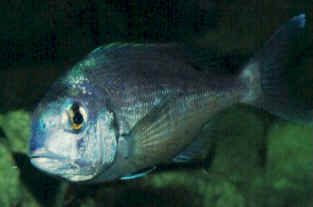Spondyliosoma cantharus - Black Bream
Phylum: Chordata - Class: Actinopterygii - Order: Perciformes - Family: Sparidae

Around the coast of Wales, black bream are quite common and can be caught during the summer months; they average around 2lb (1kg), but fish of twice that size are not uncommon. In 1986 a Welsh record specimen of 5lb 6oz was caught off Langland Bay, in south-west Wales; the Gower area is particularly good for black bream, while they are far less frequently encountered in the north of the principality.
Similar in general appearance to the gilthead bream, the black bream is easily distinguished by the absence of the gold spot near the pectoral fins. As with other bream, the body is laterally flattened; it has large large scales that cover the body and the head.
Black bream have a single long dorsal fin the front section of which comprises 11 spines, while the rear section consists of 13 or 14 soft branched rays. The eyes seem very large for the size of the head. The small sharp teeth are slightly curved.

Along the flanks of most black bream, six or seven vertical dark bands are quite noticeable, as are several golden-brown streaks.
Black bream build nests during their spring spawning period; and, as with sticklebacks, it is the male that guards the eggs. You will generally find them near the sea bed on rocky and weedy areas, and they also congregate around wrecks and natural reefs. Their main food sources are crustaceans and small fish, and these are ideal baits when fishing for black bream.
Excited at the prospect of flyfishing? So are we, and we're pretty sure you would find the Winding River Mystery trilogy of action-packed thrillers gripping reading too. Dead Drift, Dead Cert, and Dead End are Pat O'Reilly's latest river-and-flyfishing based novels, and now they are available in ebook format. Full details on our website here...
Buy each book for just £4.96 on Amazon...
Please Help Us: If you have found this information interesting and useful, please consider helping to keep First Nature online by making a small donation towards the web hosting and internet costs.
Any donations over and above the essential running costs will help support the conservation work of Plantlife, the Rivers Trust and charitable botanic gardens - as do author royalties and publisher proceeds from books by Pat and Sue.
